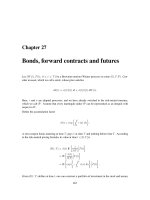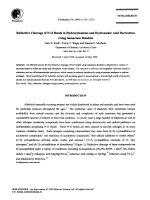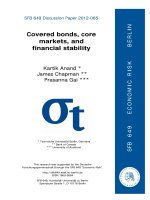Bonds, forward contracts and futures
Bạn đang xem bản rút gọn của tài liệu. Xem và tải ngay bản đầy đủ của tài liệu tại đây (136.17 KB, 8 trang )
Chapter 27
Bonds, forward contracts and futures
Let
fW t; F t; 0 t T g
be a Brownian motion (Wiener process) on some
; F ; P
. Con-
sider an asset, which we call a stock, whose price satisfies
dS t= rtStdt + tS t dW t:
Here,
r
and
are adapted processes, and we have already switched to the risk-neutral measure,
which we call
IP
. Assume that every martingale under
IP
can be represented as an integral with
respect to
W
.
Define the accumulation factor
t = exp
Z
t
0
ru du
:
A zero-coupon bond, maturing at time
T
, pays 1 at time
T
and nothing before time
T
. According
to the risk-neutral pricing formula, its value at time
t 2 0;T
is
B t; T =tIE
1
T
Ft
=IE
t
T
Ft
=IE
"
exp
,
Z
T
t
ru du
F t
:
Given
B t; T
dollars at time
t
, one can construct a portfolio of investment in the stock and money
267
268
market so that the portfolio value at time
T
is 1 almost surely. Indeed, for some process
,
B t; T =tIE
1
T
Ft
| z
martingale
= t
IE
1
T
+
Z
t
0
u dW u
= t
B 0;T+
Z
t
0
u dW u
;
dB t; T =rtt
B0;T+
Z
t
0
u dW u
dt + t t dW t
= rtB t; T dt + t t dW t:
The value of a portfolio satisfies
dX t= tdS t+ rtX t , tS tdt
= rtX t dt +ttStdW t:
(*)
We set
t=
tt
tSt
:
If, at any time
t
,
X t= Bt; T
and we use the portfolio
u;tuT
, then we will have
X T = BT; T = 1:
If
rt
is nonrandom for all
t
,then
B t; T = exp
,
Z
T
t
ru du
;
dB t; T =rtBt; T dt;
i.e.,
=0
.Then
given above is zero. If, at time
t
, you are given
B t; T
dollars and you always
invest only in the money market, then at time
T
you will have
B t; T exp
Z
T
t
ru du
=1:
If
rt
is random for all
t
,then
is not zero. One generally has three different instruments: the
stock, the money market, and the zero coupon bond. Any two of them are sufficient for hedging,
and the two which are most convenient can depend on the instrument being hedged.
CHAPTER 27. Bonds, forward contracts and futures
269
27.1 Forward contracts
We continue with the set-up for zero-coupon bonds. The
T
-forward price of the stock at time
t 2 0;T
is the
F t
-measurable price, agreed upon at time
t
, for purchase of a share of stock at
time
T
, chosen so the forward contract has value zero at time
t
.Inotherwords,
IE
1
T
S T , F t
F t
=0; 0tT:
We solve for
F t
:
0=IE
1
T
ST,Ft
F t
= IE
S T
T
F t
,
F t
t
IE
t
T
F t
=
S t
t
,
F t
t
B t; T :
This implies that
F t=
St
Bt; T
:
Remark 27.1 (Value vs. Forward price) The
T
-forward price
F t
is not the value at time
t
of
the forward contract. The value of the contract at time
t
is zero.
F t
is the price agreed upon at
time
t
which will be paid for the stock at time
T
.
27.2 Hedging a forward contract
Enter a forward contract at time 0, i.e., agree to pay
F 0 =
S 0
B 0;T
for a share of stock at time
T
.
At time zero, this contract has value 0. At later times, however, it does not. In fact, its value at time
t 2 0;T
is
V t=tIE
1
T
ST,F0
F t
= t IE
S T
T
F t
, F 0 IE
t
T
F t
= t
S t
t
, F 0B t; T
= S t , F 0B t; T :
This suggests the following hedge of a short position in the forward contract. At time 0, short
F 0
T
-maturity zero-coupon bonds. This generates income
F 0B 0;T=
S0
B 0;T
B0;T=S0:
270
Buy one share of stock. This portfolio requires no initial investment. Maintain this position until
time
T
, when the portfolio is worth
S T , F 0B T; T = ST,F0:
Deliver the share of stock and receive payment
F 0
.
A short position in the forward could also be hedged using the stock and money market, but the
implementation of this hedge would require a term-structure model.
27.3 Future contracts
Future contracts are designed to remove the risk of default inherent in forward contracts. Through
the device of markingtomarket, the value of the future contract is maintained at zero at all times.
Thus, either party can close out his/her position at any time.
Let us first consider the situation with discrete trading dates
0=t
0
t
1
::: t
n
= T:
On each
t
j
;t
j+1
,
r
is constant, so
t
k+1
= exp
Z
t
k+1
0
ru du
= exp
8
:
k
X
j =0
rt
j
t
j +1
, t
j
9
=
;
is
F t
k
-measurable.
Enter a future contract at time
t
k
, taking the long position, when the future price is
t
k
. At time
t
k+1
, when the future price is
t
k+1
, you receive a payment
t
k+1
, t
k
. (If the price has
fallen, you make the payment
,t
k+1
, t
k
. ) The mechanism for receiving and making
these payments is the margin account held by the broker.
By time
T = t
n
, you have received the sequence of payments
t
k+1
, t
k
; t
k+2
, t
k+1
; ::: ; t
n
, t
n,1
at times
t
k+1
;t
k+2
;::: ;t
n
. The value at time
t = t
0
of this sequence is
t IE
2
4
n,1
X
j =k
1
t
j +1
t
j +1
, t
j
F t
3
5
:
Because it costs nothing to enter the future contract at time
t
, this expression must be zero almost
surely.
CHAPTER 27. Bonds, forward contracts and futures
271
The continuous-time version of this condition is
t IE
"
Z
T
t
1
u
du
F t
=0; 0tT:
Note that
t
j +1
appearing in the discrete-time version is
F t
j
-measurable, as it should be when
approximating a stochastic integral.
Definition 27.1 The
T
-future price of the stock is any
F t
-adapted stochastic process
ft; 0 t T g ;
satisfying
T =ST
a.s., and (a)
IE
"
Z
T
t
1
u
du
F t
=0; 0tT:
(b)
Theorem 3.66 The unique process satisfying (a) and (b) is
t=IE
ST
Ft
;0t T:
Proof: We first show that (b) holds if and only if
is a martingale. If
is a martingale, then
R
t
0
1
u
du
is also a martingale, so
IE
"
Z
T
t
1
u
du
F t
= IE
Z
t
0
1
u
du
F t
,
Z
t
0
1
u
du
=0:
On the other hand, if (b) holds, then the martingale
M t=IE
"
Z
T
0
1
u
du
F t
satisfies
M t=
Z
t
0
1
u
du+IE
"
Z
T
t
1
u
du
F t
=
Z
t
0
1
u
du; 0 t T:
this implies
dM t=
1
t
dt;
dt=tdM t;









